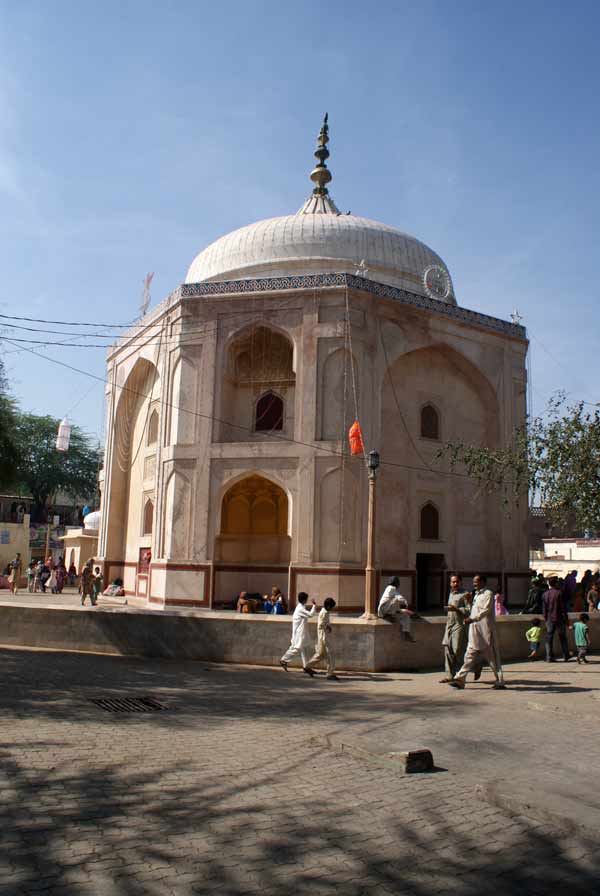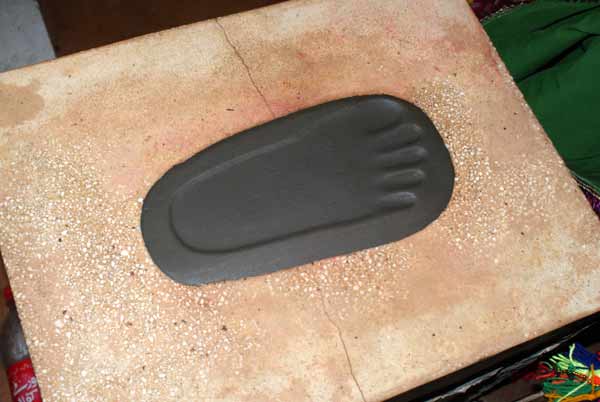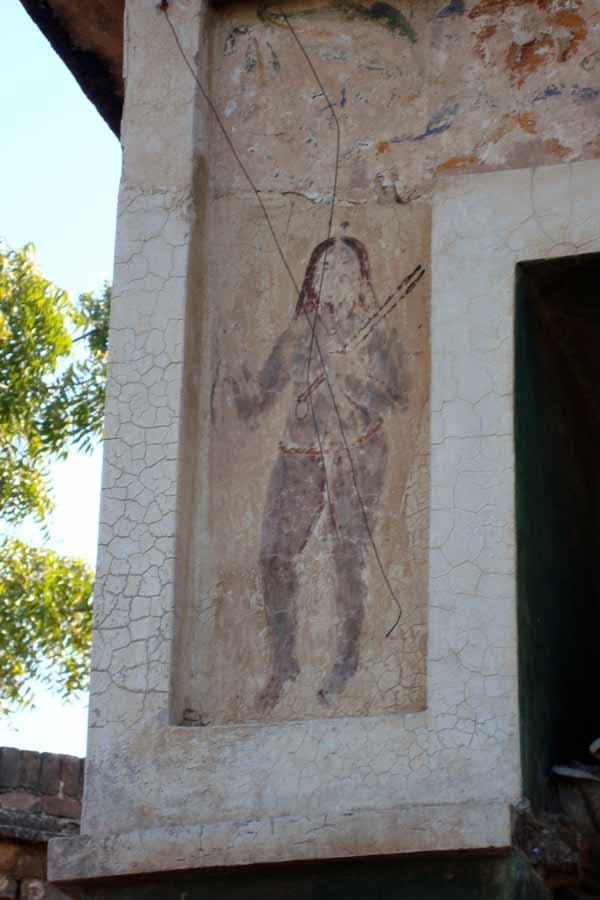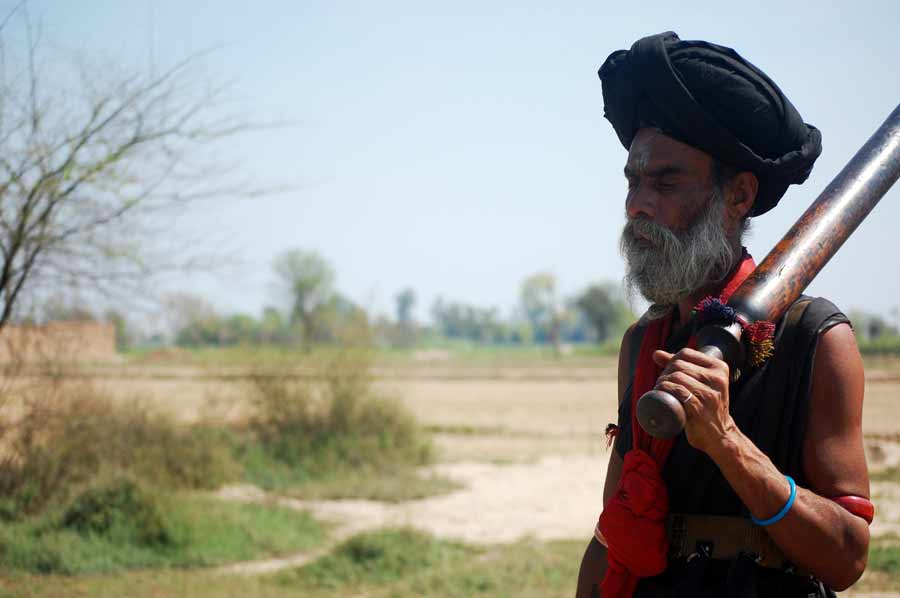Editor’s Note:
Haroon's first book is called
A White trail: A Journey into the Heart of Pakistan’s Religious Minorities. It documents the religious
festivals of five minorities living in Pakistan, including Hindu, Sikh, Parsi, Baha’i and Christian. His latest book is called
In search of Shiva: a study
of folk religious practices in Pakistan that looks at idiosyncratic Muslim shrines of the country including shrines of phallic offerings, sacred dogs,
sacred trees, shrines for transgender and other such practices.
Standing in one corner of the courtyard was this group of bald dervish. They were a combination of old ages. Their naked bodies shone through
their thin black shawls that they had used to cover up their torso. Some of them wore glass ear rings and had a horizontal tika on the forehead, a
symbol of Hindu ascetics. Others had glass bangles on their wrists, associated with Bhaktis. All of them were without shoes, even though shoes were allowed
in this courtyard. Dust had become one with the skin of their feet. Their faces and heads were clean shaven. It felt as if they had been shaving so hard
that the hair on their skin refused to grow anymore. There was uneasiness about them. They stood there uncomfortably, as if out of place. Some of them wore kohl in their eyes. Their looks could pierce through a rock.
Some of them even wore ghungroo in their feet. This is a unique feature of Islamic spirituality, where Sufi men present themselves as females to
their deity, who is imagined to be a male figure. Using references from the iconic Punjabi love legend they refer to themselves as Heer while God is
referred to as Ranjha. This is similar to the Bhakti tradition of Krishan-devotion, where the devotee presents himself as Radha, the perfect lover, to
Krishna, the deity. On closer inspection one can see that Ranjha of this folk love legend borrows heavily from the legends of Krishna. He too is a cowherd
and plays the flute. Like Krishna, Ranjha too doesn’t marry his perfect lover, Heer. Their love transcends the boundaries of human made institutions.
Bulleh Shah, the 18th century Punjabi mystic and poet from Kasur, captures the essence of the fluidity between Krishna and Ranjha in his poem in
the following way:
Krishna plays the magical flute
O Ranjha with the flute –
O cowherd Ranjha!
You are in tune with all of us!
You make your delights
Chime with your consciousness
Krishna plays the magic flute
O flute player,
You are called Krishna
You are our virtue
You are our inner self
Yet our eyes cannot quite see you!
How complex your sport.
Krishna plays the magic flute.
In the case of this shrine the occupant of the grave becomes a symbol of divinity while the dervish with the ghungroo his female lover.
There is a sexual connotation to this meeting of lovers. The grave of the saint, the groom is decorated like a groom, with a turban placed where the head
of the occupant would be. Today is a special occasion. This is the celebration of the urs of the saint, a day of his death. In the Islamic
spirituality, death, as opposed to birth, of a saint is celebrated. This is because it is believed that after death, the saint, lover, becomes one with the
beloved, which is God. Whereas to God the saint is a female, to his devotees he is a male and they the female.
A lot of Sufi dervish, also encapsulate this duality of sexuality in their body,
entertaining simultaneously the male and female features.
In this form they represent Ardhanarisvara – a form of Lord Shiva
with the right side being male and the left one being female.
The two cannot survive without each other and are reconciled by Lord Shiva. This duality is also reflected in Shiva being seen as the creator and the
destroyer simultaneously. The image of Shiva which is the union of linga (penis) and yoni (vagina) is the ultimate symbol of the union of
masculinity with femininity.

The mausoleum of Daud Bandagi
In front of the dervish is the 16th century monument, tomb of the Sufi saint Daud Bandagi Kirmani. It is a typical Mughal construction
with an octagonal base and a round bulbous white dome. The shrine is covered by a protective wall and there are several other graves in this courtyard,
some of his descendants and others of rich people from the city who paid or vied to be buried close to the saint, hoping to achieve salvation through their
proximity.
The shrine is located in the centre of this city of Shergarh, a historical city located about 100 kilometers south of Lahore. The city as well is protected
by a fort like wall. Whereas such walls of larger cities in India were razed down by the British after 1857, they remained untouched in smaller cities. The
entire city was celebrating the annual 3 day celebration of the urs of the saint. All streets and roads in here had been converted into a
makeshift bazaar. Smell of freshly prepared samosa lingered in the air. Some were selling eatables to those who did not want to partake in the langaar at the shrine. Most of the shops were selling religious paraphernalia – sacred threads, bangles, rings with special stones, items one is
likely to encounter outside major Hindu temples. In fact to an unacquainted visitor this might as well be the threshold of a Hindu temple. The only
difference would be the posters. All the posters here represented iconic Muslim saints like Daud Bandagi, Baba Farid, and Shahbaz Qalandar, while posters
outside Hindu temples sell Hindu images. Women, men, children, old and young, all throng to the shrine for these festivities.
Walking in the midst of the folk are Pirs and dervish. Some offer their services to the locals, promising respite from an evil eye.
Others prepare their own magical spells that need to be mixed with water and consumed. These Sufis belong to various hues. There are those who belong to a
conventional, orthodox Sufi sect, like Daud Bandagi Kirmani, who belonged to the Qadiri sect. For them following religious doctrines is as much part of
religion as shrines of saints. There are various distinctions within these conventional sects but there is no need to get into these subtleties here. Then
there are the Malmatis – the rebel Sufis, who flout religious laws, and don’t belong to any particular order. These are the ones who through their action
want to invite the wrath of the people. They believe this to be a passage towards God. They convert the sacred into profane, and profane into sacred. They
are similar to the Tantric devotees of Shiva.
Scattered all around the city are the massive havelis of the descendants of the saint. The gates of their houses, manned by armed security guards
are thrown open for these 3 days to entertain guests on the occasion of the urs. Not all guests though, only of a particular background. Most of
them don’t live here anymore but are based in Lahore. They return annually for this festival. They are the most influential people of their city, the
politicians, the businesspeople, feudal, intellectuals, bureaucrats, and of course the religious heads. Different governments including the Mughals and
British have awarded vast tracts of lands to Sufi shrine establishments as a religious duty and also to appease these influential men. Most of these
shrines still retain this land and their descendants reap the benefit.
I walked into the main shrine of Daud Bandagi Kirmani. The walls were beautifully decorated in traditional tile work. The grave of the saint was right in
the centre while devotees circumambulated around the room and then stopped next to the tombstone of the saint, where they would offer a special prayer.

Daud Bandagi's footmark inside the shrine
Here next to the grave of the saint, on a raised platform was the preserved footmark of the saint. Some devotees prayed here while others kissed. Looking
at this structure I was immediately reminded of Jain temples, where also there are footmarks of saints, around which that temple is constructed. I was
reminded of the footmarks of Shri Atmaramji that I had seen at the Lahore museum. Like this one at this Muslim shrine they too were made out of marble.
Shri Atmaramji was a prominent Jain Acharya from Gujranwala. His smadh still exists in Gujranwala and is being used as a police station. Sometimes
innocent people are tortured at the shrine which once preached non-violence. The sight also reminded me of a Muslim shrine that I had heard about at the
archaeological mound of Marot near Bahawalpur. This mound is located close to the India-Pakistan border with Rajasthan on one side and the district of
Bahawal Nagar on the other. Here too there is a Muslim shrine dedicated to the footmarks of Hazrat Ali, the son-in-law of the Prophet of Islam. It is
believed that he worshipped at this place.
Worshipping of the footmarks is not the only feature that united these distinct religious traditions. My thought went back to the dervish I had
seen outside. Their semi-naked bodies, their shaved heads, and beardless faces reminded me of sadhus from Digamber Jain, who too remove their
bodily hair, as a symbol of renunciation of the world and don’t wear clothes. “You know these dervish only cover up when they visit a public
place, like this one,” said Iqbal Qaiser, my friend and companion. “When they are in their deras they only wear a longi or sometimes
nothing at all.”
These dervish were distinctively different from other Malamti dervish here. The other dervishes let their hair long and grow
their beard, which too serves as a symbol of renunciation of the world. Where do the knots of these dervish and Digamber Sadhu tie together?
There is no doubt that the latter became an inspiration for the former but what were the pathways that allowed for this influence to reach the other. I was
dumbfounded.
A few years later I was visiting another historical city of Bhera where I found myself in the premises of an abandoned Sikh shrine. On the walls of this
shrine, made out of colorful frescoes I saw a figure which had uncanny similarities to the dervish at Shergarh or Digamber Sadhus. The figure wore
nothing but a lungi and held a tomba in his hand.

Figure of an Udasi Sadhu at a Sikh shrine in Bhera
In the Sikh tradition these Sadhus are called Udasi Sadhu. Udasi is a Sansrkit term that means pilgrimage. Their perpetual pilgrimage
from one shrine to another earned them this nickname. It is interesting to note that these Sadhus derive their spiritual lineage from Sri Chand, the eldest
son of Guru Nanak. Whereas Guru Nanak spoke vehemently against such extreme asceticism, his own son defied his orders and became an ascetic. Perhaps in his
own way he was punishing Guru Nanak for abandoning him as a child to depart on his own udasi that nearly took 30 years. This complicated
relationship between the father and son continued when Nanak instead of appointing his son as his spiritual descendant, appointed his disciple Bhai Lehna
and rechristened him, Guru Angad.
Pictures of Sri Chand depict him wearing nothing but a lungi. Sri Chand had a disciple called Baba Gurditta, who in turn had four disciples, Balu
Hasna, Al-Mast, Phool Shah and Govinda. It is believed that the first two were Muslims and through them Muslim too were attracted to the movement of Sri
Chand. Some of these devotees grew their hair while others removed them like Digamber Jains. They shunned clothes and started living in secluded
communities called dera. They would only cover temporarily when they had to enter mainstream society. They would also scrub oil and ash over their
body, associating with death and rejecting this temporary life. They became famous as Nanghe Sadhu.

A malang on his way to the next shrine
Perhaps the dervish I had noticed at the shrine of Daud Bandagi belonged to this tradition of Balu Hasna and Al Mast. They remain in groups and
spend their entire lives in perpetual udasi. They can be noticed at every prominent Sufi shrine of the country. Maybe it was through Sri Chand
that influences of Digamber asceticism entered folk Islamic spirituality. Or maybe such extreme asceticism was already part of the folk religious tradition
of India which was later institutionalized by Digamber Jains. Perhaps these Nanghe Sadhu at Shergarh represent that primordial religiosity, before
it was encoded into a religious tradition.